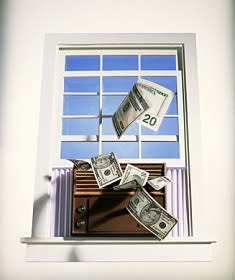Five air-conditioning myths busted
By Lori Bongiorno
More from The Conscious Consumer blog

This summer's record-breaking-high temperatures have made air conditioning a necessity for many Americans. But that doesn't mean you need to spend a fortune to stay cool.
Falling prey to common air-conditioning myths can lead to overspending. That's why it's important to understand what's fact and what's fiction when it comes to using your A/C.
Below are some facts that will help you spend your cooling dollars wisely so you can achieve maximum comfort with minimum strain on your wallet.
Myth: Cranking your air conditioner up high (by setting your unit's thermostat significantly below the temperature you want to achieve) will cool your house faster.
Fact: Your air conditioner will deliver cool air at the same rate no matter how low you go on the thermostat setting. If you turn the thermostat to 50 degrees when you want it to get to 72 degrees, your room won't get cooler any faster, says Jamy Bacchus at the Natural Resources Defense Council (NRDC). He uses this analogy to illustrate the concept: If you are driving from New York to Philadelphia and you set your GPS to Washington D.C. you aren't going to get to Philadelphia any faster.
The one exception, Bacchus says, is if your room air conditioner has a "low, medium, high" setting instead of a thermostat. In that case, setting your unit up to high will cool the room faster, but you should remember to turn it down to low or medium once your room feels comfortable so you don't waste energy and money.
Myth: It's more efficient to leave your air conditioning running when you're not at home than it is to turn off your room unit (or raise the temperature on your central system's thermostat) and re-cool your house when you get home.
Fact: It is far more inefficient and expensive to leave the A/C on all day than it is to turn it off (or raise the thermostat), says Paul McRandle of NRDC's Simple Steps. His explanation: "While you're away, there's no need to keep replacing cool air with more cool air many times over. This just forces your A/C's compressor--the most energy-consuming element in your system--to operate regularly (even if not constantly) for the 8-10 hours you're out."
The bottom line: Turn your air conditioning down when you leave the house for extended periods and set a timer for about a half hour before you return home. You'll save money without sacrificing comfort.
Myth: Purchasing an energy-efficient air conditioner will automatically reduce your electric bills.
Fact: Buying an energy-efficient air conditioner will definitely help, but size is also an important factor when it comes to efficiency. Your unit needs to be the right size for the space you are trying to cool. "Don't buy a bigger unit than you need thinking that it is going to cool faster," says Bacchus. "Save yourself the money and buy a more efficient correctly sized unit."
If your unit is too big, then it will not remove humidity effectively, and your space will be cool, but damp and clammy. If it's too small, it will struggle to keep your room cool, never really cycle off, and over-dry your air, according to Bacchus. How do you know what just the right size is? Here are details on proper sizing from Energy Star.
Myth: Leaving a ceiling fan on will cool a room even if no one is in it.
Fact: Leaving your ceiling fan on when you're not in the room is a waste of energy and money because fans cool people, not rooms. Ceiling fans circulate the air in the room to create a draft. This makes you feel cooler, but doesn't lower the temperature of the room. Make sure your fan is set to run counter-clockwise in the summer so it directs air downward to create a breeze.
Myth: Your air-conditioning unit will perform the same no matter where you install it.
Fact: Like size, installation is another key factor when it comes to efficiency. It's not a good idea to place lights or televisions near your air-conditioner's thermostat because it can sense the heat given off from appliances and cause your unit to run longer than it needs to.
Try to install your unit in the shade and on your home's north or east side when possible because direct sunlight on your unit's outdoor heat exchanger can negatively impact efficiency. If you plant trees and shrubs around your unit, make sure you don't block the airflow around the unit.
Environmental journalist Lori Bongiorno shares green-living tips and product reviews with Yahoo! Green's users. Send Lori a question or suggestion for potential use in a future column. Her book, Green Greener Greenest: A Practical Guide to Making Eco-smart Choices a Part of Your Life is available on Yahoo! Shopping and Amazon.com.
